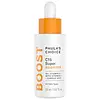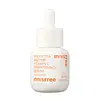What's inside
What's inside
 Key Ingredients
Key Ingredients

 Benefits
Benefits

 Ingredients Side-by-side
Ingredients Side-by-side

Water
Skin ConditioningAscorbic Acid
AntioxidantGlycerin
HumectantEthoxydiglycol
HumectantPPG-26-Buteth-26
Skin ConditioningMannitol
HumectantTridecapeptide-1
Skin ConditioningPalmitoyl Tripeptide-5
Skin ConditioningErgothioneine
AntioxidantSodium Hyaluronate
HumectantPentylene Glycol
Skin ConditioningPEG-40 Hydrogenated Castor Oil
EmulsifyingBisabolol
MaskingSodium Gluconate
Skin ConditioningDecylene Glycol
Skin ConditioningFerulic Acid
AntimicrobialOryza Sativa Bran Extract
Skin ConditioningTocopherol
AntioxidantPolyacrylate Crosspolymer-6
Emulsion Stabilising1,2-Hexanediol
Skin ConditioningPanthenol
Skin ConditioningSodium Phytate
Sodium Hydroxide
BufferingCitric Acid
BufferingPhenoxyethanol
PreservativeWater, Ascorbic Acid, Glycerin, Ethoxydiglycol, PPG-26-Buteth-26, Mannitol, Tridecapeptide-1, Palmitoyl Tripeptide-5, Ergothioneine, Sodium Hyaluronate, Pentylene Glycol, PEG-40 Hydrogenated Castor Oil, Bisabolol, Sodium Gluconate, Decylene Glycol, Ferulic Acid, Oryza Sativa Bran Extract, Tocopherol, Polyacrylate Crosspolymer-6, 1,2-Hexanediol, Panthenol, Sodium Phytate, Sodium Hydroxide, Citric Acid, Phenoxyethanol
Water
Skin ConditioningPropanediol
Solvent1,2-Hexanediol
Skin ConditioningGlycerin
Humectant3-O-Ethyl Ascorbic Acid
Skin ConditioningButylene Glycol
HumectantLactobacillus Ferment Lysate
Skin ConditioningSqualane
EmollientHelianthus Annuus Seed Oil
EmollientDextrin
AbsorbentAcrylates/C10-30 Alkyl Acrylate Crosspolymer
Emulsion StabilisingCaprylic/Capric Triglyceride
MaskingTromethamine
BufferingXanthan Gum
EmulsifyingGluconolactone
Skin ConditioningCitrus Reticulata Peel Extract
Skin ConditioningPanthenol
Skin ConditioningNiacinamide
SmoothingAllantoin
Skin ConditioningDaucus Carota Sativa Root Extract
Skin ConditioningHyaluronic Acid
HumectantPentylene Glycol
Skin ConditioningSodium Metaphosphate
BufferingSilica Dimethyl Silylate
EmollientCyclodextrin
AbsorbentTocopherol
AntioxidantEthylhexylglycerin
Skin ConditioningMadecassoside
AntioxidantHydrogenated Poly(C6-20 Olefin)
AbrasiveProtease
ExfoliatingAscorbyl Tetraisopalmitate
AntioxidantGlutathione
Achillea Millefolium Extract
CleansingHdi/Trimethylol Hexyllactone Crosspolymer
Beta-Carotene
Skin ConditioningFerulic Acid
AntimicrobialWater, Propanediol, 1,2-Hexanediol, Glycerin, 3-O-Ethyl Ascorbic Acid, Butylene Glycol, Lactobacillus Ferment Lysate, Squalane, Helianthus Annuus Seed Oil, Dextrin, Acrylates/C10-30 Alkyl Acrylate Crosspolymer, Caprylic/Capric Triglyceride, Tromethamine, Xanthan Gum, Gluconolactone, Citrus Reticulata Peel Extract, Panthenol, Niacinamide, Allantoin, Daucus Carota Sativa Root Extract, Hyaluronic Acid, Pentylene Glycol, Sodium Metaphosphate, Silica Dimethyl Silylate, Cyclodextrin, Tocopherol, Ethylhexylglycerin, Madecassoside, Hydrogenated Poly(C6-20 Olefin), Protease, Ascorbyl Tetraisopalmitate, Glutathione, Achillea Millefolium Extract, Hdi/Trimethylol Hexyllactone Crosspolymer, Beta-Carotene, Ferulic Acid
 Reviews
Reviews

Ingredients Explained
These ingredients are found in both products.
Ingredients higher up in an ingredient list are typically present in a larger amount.
1,2-Hexanediol is a synthetic liquid and another multi-functional powerhouse.
It is a:
- Humectant, drawing moisture into the skin
- Emollient, helping to soften skin
- Solvent, dispersing and stabilizing formulas
- Preservative booster, enhancing the antimicrobial activity of other preservatives
Ferulic Acid is a plant based antioxidant. By fighting free-radicals, ferulic acid can help reduce the formation of fine lines and hyperpigmentation.
When used with Vitamin C, Ferulic Acid has shown to prevent Vitamin C from breaking down. In other words, it acts as a stabilizer.
Ferulic Acid is sometimes used to preserve food. Foods containing Ferulic Acid include: oats, rice, eggplant, citrus.
In medicine, Ferulic Acid is being studied for helping with diabetes, Alzheimer's, and cardiovascular diseases.
Learn more about Ferulic AcidGlycerin is already naturally found in your skin. It helps moisturize and protect your skin.
A study from 2016 found glycerin to be more effective as a humectant than AHAs and hyaluronic acid.
As a humectant, it helps the skin stay hydrated by pulling moisture to your skin. The low molecular weight of glycerin allows it to pull moisture into the deeper layers of your skin.
Hydrated skin improves your skin barrier; Your skin barrier helps protect against irritants and bacteria.
Glycerin has also been found to have antimicrobial and antiviral properties. Due to these properties, glycerin is often used in wound and burn treatments.
In cosmetics, glycerin is usually derived from plants such as soybean or palm. However, it can also be sourced from animals, such as tallow or animal fat.
This ingredient is organic, colorless, odorless, and non-toxic.
Glycerin is the name for this ingredient in American English. British English uses Glycerol/Glycerine.
Learn more about GlycerinPanthenol is a common ingredient that helps hydrate and soothe the skin. It is found naturally in our skin and hair.
There are two forms of panthenol: D and L.
D-panthenol is also known as dexpanthenol. Most cosmetics use dexpanthenol or a mixture of D and L-panthenol.
Panthenol is famous due to its ability to go deeper into the skin's layers. Using this ingredient has numerous pros (and no cons):
Like hyaluronic acid, panthenol is a humectant. Humectants are able to bind and hold large amounts of water to keep skin hydrated.
This ingredient works well for wound healing. It works by increasing tissue in the wound and helps close open wounds.
Once oxidized, panthenol converts to pantothenic acid. Panthothenic acid is found in all living cells.
This ingredient is also referred to as pro-vitamin B5.
Learn more about PanthenolPentylene glycol is typically used within a product to thicken it. It also adds a smooth, soft, and moisturizing feel to the product. It is naturally found in plants such as sugar beets.
The hydrophilic trait of Pentylene Glycol makes it a humectant. As a humectant, Pentylene Glycol helps draw moisture from the air to your skin. This can help keep your skin hydrated.
This property also makes Pentylene Glycol a great texture enhancer. It can also help thicken or stabilize a product.
Pentylene Glycol also acts as a mild preservative and helps to keep a product microbe-free.
Some people may experience mild eye and skin irritation from Pentylene Glycol. We always recommend speaking with a professional about using this ingredient in your routine.
Pentylene Glycol has a low molecular weight and is part of the 1,2-glycol family.
Learn more about Pentylene GlycolTocopherol (also known as Vitamin E) is a common antioxidant used to help protect the skin from free-radicals and strengthen the skin barrier. It's also fat soluble - this means our skin is great at absorbing it.
Vitamin E also helps keep your natural skin lipids healthy. Your lipid skin barrier naturally consists of lipids, ceramides, and fatty acids. Vitamin E offers extra protection for your skin’s lipid barrier, keeping your skin healthy and nourished.
Another benefit is a bit of UV protection. Vitamin E helps reduce the damage caused by UVB rays. (It should not replace your sunscreen). Combining it with Vitamin C can decrease sunburned cells and hyperpigmentation after UV exposure.
You might have noticed Vitamin E + C often paired together. This is because it is great at stabilizing Vitamin C. Using the two together helps increase the effectiveness of both ingredients.
There are often claims that Vitamin E can reduce/prevent scarring, but these claims haven't been confirmed by scientific research.
Learn more about TocopherolWater. It's the most common cosmetic ingredient of all. You'll usually see it at the top of ingredient lists, meaning that it makes up the largest part of the product.
So why is it so popular? Water most often acts as a solvent - this means that it helps dissolve other ingredients into the formulation.
You'll also recognize water as that liquid we all need to stay alive. If you see this, drink a glass of water. Stay hydrated!
Learn more about Water